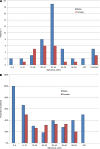Pre-treatment lost to follow-up tuberculosis patients, Chongwe, Zambia, 2017: a retrospective cohort study
- PMID: 32368520
- PMCID: PMC7181362
- DOI: 10.5588/pha.19.0059
Pre-treatment lost to follow-up tuberculosis patients, Chongwe, Zambia, 2017: a retrospective cohort study
Abstract
Setting: Four tuberculosis (TB) diagnostic health facilities of the Chongwe District, Zambia.
Objective: To determine the frequency of bacteriologically confirmed TB patients lost to follow-up (LTFU) before treatment from January to December 2017.
Design: This is a retrospective cohort study involving the review of TB registers. Information on presumptive TB patients who tested positive either by smear microscopy or Xpert® MTB/RIF assay was extracted from the laboratory TB registers of the TB diagnostic facilities and cross-matched with the TB treatment registers of TB treatment facilities.
Results: Two hundred and seventeen bacteriologically confirmed TB patients were found in the laboratory TB registers. Of these, 145 (67%) were males and seven (3%) were children; 177 (81%) patients were diagnosed using Xpert, while the remaining 40 (19%) were diagnosed using sputum smear microscopy. A total of 71 (33%) were not linked to treatment. Those diagnosed using smear microscopy were 2.5 times (95% CI 1.1-5.3) more likely to be LTFU before treatment than those diagnosed using Xpert.
Conclusion: About one third of TB patients who were not linked to treatment could potentially extend the duration of bacilli transmission in their communities. National TB control programmes should consider including LTFU patients before treatment in routine monitoring and evaluation.
Contexte: Quatre structures de diagnostic de la tuberculose (TB) dans le district de Chongwe, Zambie.
Objectif: Déterminer le nombre de patients TB perdus de vue (LTFU) avant le traitement ayant une confirmation bactériologique de janvier à décembre 2017.
Schéma: Etude rétrospective de cohorte impliquant la consultation des registres TB. Les informations relatives aux patients présumés TB qui ont été positifs par microscopie de frottis ou test Xpert® MTB/RIF ont été extraites des registres du laboratoire de TB et croisés avec les registres de traitement de la TB dans les structures de traitement.
Résultats: Parmi les 217 patients TB confirmés par bactériologie et identifiés dans les registres du laboratoire TB, 145 (67%) ont été des hommes et 7 (3%) ont été des enfants. Ont été diagnostiqués 177 (81%) patients par Xpert, tandis que 40 (19%) ont été diagnostiqués par microscopie de frottis de crachats. Un total de 71 (33%) n’a pas été lié au traitement. Les patients diagnostiqués par microscopie de crachats ont été 2,5 fois (IC95% 1,1–5,3) plus susceptibles d’être perdus de vue avant le traitement que ceux diagnostiqués par Xpert.
Conclusion: Environ un tiers des patients TB n’a pas été connecté à la prise en charge et ces patients ont pu potentiellement allonger la durée de la transmission des bacilles dans leurs communautés. Les programmes nationaux de lutte contre la TB devraient envisager d’inclure les patients LTFU avant le traitement en suivi et évaluation de routine.
Marco de referencia: Cuatro establecimientos de diagnóstico de la tuberculosis (TB) en el distrito Chongwe de Zambia.
Objetivo: Determinar la pérdida durante el seguimiento (LTFU) antes de iniciar el tratamiento de los pacientes con diagnóstico de TB y confirmación bacteriológica de enero a diciembre del 2017.
Método: Fue este un estudio de cohortes retrospectivo a partir del análisis de los registros de TB. La información sobre los pacientes con presunción de TB que obtuvieron resultados positivos ya sea de la baciloscopia o la prueba Xpert® MTB/RIF se extrajo de los registros de laboratorio en los establecimientos de diagnóstico de la TB y se cotejó con los datos de los registros de tratamiento de los centros de tratamiento de la TB.
Resultados: En los registros de los laboratorios de TB se encontraron 217 pacientes con diagnóstico de TB y confirmación bacteriológica. De estos, 145 (67%) eran de sexo masculino y siete (3%) eran niños. El diagnóstico se obtuvo en 177 pacientes (81%) con la prueba Xpert y en los 40 restantes (19%) mediante la baciloscopia del esputo. Setenta y un pacientes (33%) no se vincularon a los servicios de tratamiento. La LTFU anterior al tratamiento fue 2,5 veces más frecuente en los pacientes diagnosticados mediante baciloscopia (IC95% 1,1–5,3) que en los pacientes diagnosticados con la prueba Xpert.
Conclusión: Cerca de un tercio de los pacientes con TB no se vinculó a los servicios de tratamiento, lo cual pudo prolongar la transmisión de los bacilos en sus comunidades. Es necesario que los Programas Nacionales contra la TB tengan en cuenta la inclusión de los pacientes con LFTU anterior al tratamiento en el seguimiento y la evaluación sistemáticos.
Keywords: TB; Zambia; epidemiology; pre-treatment lost to follow-up; treatment.
© 2020 The Union.
Conflict of interest statement
Conflicts of interest: none declared.
Figures



References
-
- World Health Organization Global tuberculosis report, 2017. Geneva, Switzerland: WHO; 2017. WHO/HTM/TB/2017.23.
-
- World Health Organization The definitions and reporting framework for tuberculosis—2013 revision. Geneva, Switzerland: WHO; 2014. http://apps.who.int/iris/bitstream/10665/79199/1/9789241505345_eng.pdf Accessed February 2020.
-
- National Tuberculosis and Leprosy Programme, Ministry of Health, Republic of Zambia Tuberculosis manual. 5th ed. Lusaka, Zambia: MoH; 2017.
-
- Ministry of Health, Republic of Zambia National TB prevalence survey 2013–2014 Report. Lusaka, Zambia: MoH; 2015.
LinkOut - more resources
Full Text Sources

